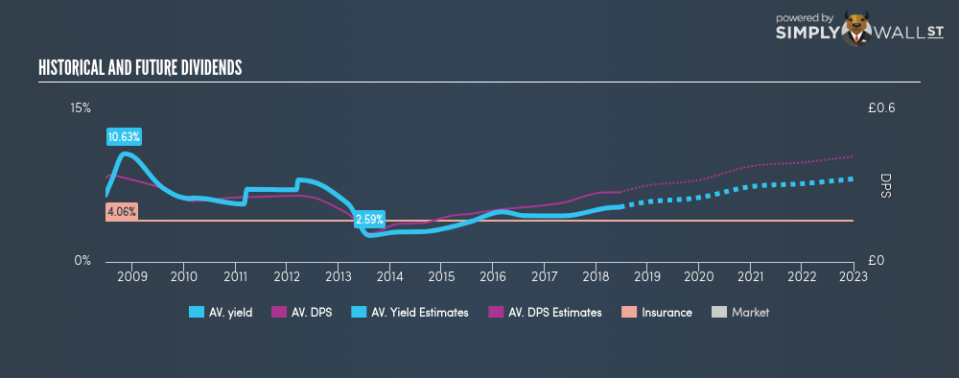Is Aviva plc (LON:AV.) A Great Dividend Stock?

Dividends can be underrated but they form a large part of investment returns, playing an important role in compounding returns in the long run. Over the past 10 years, Aviva plc (LON:AV.) has returned an average of 6.00% per year to shareholders in terms of dividend yield. Should it have a place in your portfolio? Let’s take a look at Aviva in more detail. View out our latest analysis for Aviva
Here’s how I find good dividend stocks
If you are a dividend investor, you should always assess these five key metrics:
Is its annual yield among the top 25% of dividend-paying companies?
Has it consistently paid a stable dividend without missing a payment or drastically cutting payout?
Has it increased its dividend per share amount over the past?
Does earnings amply cover its dividend payments?
Based on future earnings growth, will it be able to continue to payout dividend at the current rate?
How does Aviva fare?
The company currently pays out 78.25% of its earnings as a dividend, according to its trailing twelve-month data, meaning the dividend is sufficiently covered by earnings. However, going forward, analysts expect AV.’s payout to fall to 56.17% of its earnings, which leads to a dividend yield of 6.60%. However, EPS should increase to £0.47, meaning that the lower payout ratio does not necessarily implicate a lower dividend payment.
If dividend is a key criteria in your investment consideration, then you need to make sure the dividend stock you’re eyeing out is reliable in its payments. Dividend payments from Aviva have been volatile in the past 10 years, with some years experiencing significant drops of over 25%. These characteristics do not bode well for income investors seeking reliable stream of dividends.
Compared to its peers, Aviva generates a yield of 5.39%, which is high for Insurance stocks.
Next Steps:
Taking into account the dividend metrics, Aviva ticks most of the boxes as a strong dividend investment, putting it in my list of top dividend payers. Given that this is purely a dividend analysis, you should always research extensively before deciding whether or not a stock is an appropriate investment for you. I always recommend analysing the company’s fundamentals and underlying business before making an investment decision. There are three fundamental aspects you should further research:
Future Outlook: What are well-informed industry analysts predicting for AV.’s future growth? Take a look at our free research report of analyst consensus for AV.’s outlook.
Valuation: What is AV. worth today? Even if the stock is a cash cow, it’s not worth an infinite price. The intrinsic value infographic in our free research report helps visualize whether AV. is currently mispriced by the market.
Other Dividend Rockstars: Are there better dividend payers with stronger fundamentals out there? Check out our free list of these great stocks here.
To help readers see pass the short term volatility of the financial market, we aim to bring you a long-term focused research analysis purely driven by fundamental data. Note that our analysis does not factor in the latest price sensitive company announcements.
The author is an independent contributor and at the time of publication had no position in the stocks mentioned.

 Yahoo Finance
Yahoo Finance 
